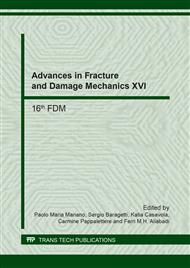p.31
p.35
p.39
p.43
p.47
p.51
p.55
p.59
p.63
Creep Damage Tolerance Factor λ of Selected Creep-Resistant Steels
Abstract:
The creep damage tolerance factor λ as an important outcome of the continuum damage mechanics approach has been used to asses the creep fracture mode and the susceptibility of material to localized cracking at strain concentrations. In this work, using sets of our earlier published creep data of three advanced ferritic creep-resistant steels (T23 low alloy steel, P91 and P92 chromium steels) are analysed in terms of the creep damage tolerance factor λ. It was found that the value of the creep damage factor λ is not constant and depends on the creep loading conditions. The data analysis is followed by fractographic investigations, which is used to identify the creep fracture mode (s) experimentally.
Info:
Periodical:
Pages:
47-50
Citation:
Online since:
September 2017
Authors:
Price:
Сopyright:
© 2017 Trans Tech Publications Ltd. All Rights Reserved
Share:
Citation:


